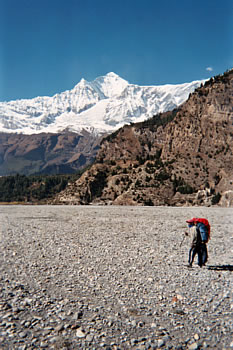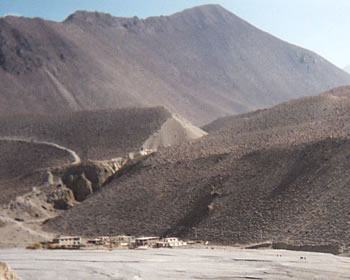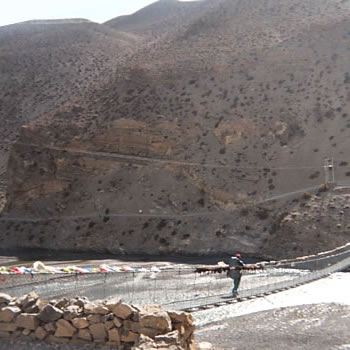| |
Sunday,
November 16
From Pokhara to Muktinath
The
morning of the trek, Krishna showed up with two of his younger
brothers, Lila and Bira. We all packed into a taxi van with
our gear and headed for the airport. It was a flight on Cosmic
Air, in a small twin prop plane that flew very low and at
times very close to the spectacular mountains, with a lot
of buffeting and a scary turn at the end just before landing.
Even Krishna, who had made this flight many times, clung to
Rob's arm at some points. I was tempted to jump out and kiss
the ground when we arrived safely.
The change in temperature
caught me off guard. It was frightfully cold. We grabbed our
backpacks (day packs for us, the big packs for them). Quickly
I put on every warm thing I had that I wasn't wearing already.
We walked through the terminal at Jomosom, which was quite
a small terminal, out onto the main street. The street was
paved with flat stones, lined with one or two story buildings.
Behind us I heard several deeply resonant bells approaching,
and I turned to see a yak pack train coming up the main street.
The pack animals wear bells, and often the lead animals are
festooned with big red headdresses. In this part of the district
of Mustang, just across the border from Tibet, there is no
motor vehicle access other than airplanes. So all goods that
come in or go out do so on the back of a pack animal or a
human. The trail we would trek was the main trade route and
we would encounter pack trains and humans carrying incredible
loads all through the trek.
We had flown from
Pokhara at about 900 m. (3000 ft.) or so elevation, to Jomosom
at about 2710 m. (9000 ft.). And that very day, the first
day of the trek, we would hike up for the next 6 or 7 hours
to Muktinath at over 3650 m. (12,000 ft.). I knew the altitude
was going to kick our butts, and it did.
We had breakfast
(tsampa porridge and coffee for me), then went to register
at a government office. We filled our water bottles at a government
run storefront where they produce purified water with a small
ozone treating system. (The idea is to reduce the number of
plastic water bottles that are discarded.) We went through
a checkpoint and then set out, Krishna setting a very fast
pace. Quickly we left the flat stone pavement of the Jomosom
street and trekked on a well beaten trail that led down to
the riverbed. It being the dry season, a lot of distance could
be saved by trekking over the loose stones of the riverbed
instead of following the trail along the bank. The wind gusted
at our backs. It was physically challenging, already feeling
some effects of the altitude, the lungs less able to supply
the legs with oxygen.

After an hour or
two of riverbed trekking, during which we were passed by a
number of pack trains coming toward Jomosom and trekkers who
were returning from spending the night in Muktinath or who
were weeks into a trek of the entire Annapurna Circuit, we
climbed back onto the riverbank and trekked up to a long and
lofty bridge, like a rope bridge but made of steel cable and
a footway of steel slats. The bridge bounced with the footsteps
and swayed because of gusts of wind, and in the center, over
the part where the river flowed far below, the wind gusts
were intense, blowing me over to the side of the bridge. But
it was beautiful and exhilarating as well as scary. And only
the first of many suck bridges.
- - - - - - -
The bridge took us to the opposite bank of the river, and
we trekked along it. The general trend for the rest of the
day was increasing elevation. Along with this came a decreasing
ability of my lungs to supply my body with oxygen.

The next village
we came to was Khagbeni. We stopped at some outside tables
at one of the teahouses, out of the wind but in the warm sun.
We ordered tea and Rob had a piece of apple pie. An Australian
couple headed the opposite direction from us stopped and ordered
some tea and pastries. They were wearing shorts and looked
very weathered. They were doing the entire Annapurna circuit,
they said, and had included some days before they could get
truly clean again.
The higher we got,
the slower I went. I learned to use my two trekking poles
to allow my arms to take some of the weight and help my legs
out with the constant climbing. Hour after hour we trekked
through the desolate landscape, which made me feel very small
and far away from everything familiar. The blustery cold wind
was at our backs, sometimes seeming to help push us along.
It all seemed to take on a very poetic feeling. As if the
trek were moving through one vast temple, with the ceremonial
silences interspersed with sounds of rushing wind and running
water from the creeks we passes, and little temples by the
trail where I could here people chanting and at other times
singing, And below us where there were some areas of soil,
little farms where people invoked the sacraments of life.
A woman and a man plowing their field with oxen. The growing
of food, a few green trees in the vast brown vista. The continuity
of life in a world of rock and wind and sky and water and
sun. And the rhythm of the trek, one step then another, arms
and feet, despite the increasing reluctance of the lungs.
The last couple of
miles were brutally difficult as we approached Muktinath at
over 12,000 feet. I caught up with Rob and Krishna at a tea
house where Rob had already ordered tea for us. It was about
4 in the afternoon, and the sun had already gone behind the
mountains. The air became colder by the minute. This tea house
was the place we were planning on staying. We ordered some
lunch, when Krishna casually announced that there were no
rooms available. We urged him to go to the other nearby teahouses
and find some rooms before they all filled up. Before lunch
arrived, he was back, announcing that he had found some.
For lunch I had what
is basically the national dish of Nepal, dahl bat. It always
includes a pile of white rice, a cup of lentil soup (to pour
on the rice) and a pile of curried vegetables featuring potato.
Sometimes you get cooked greens and/or some spicy pickle with
it. And the best part, aside from the fact that it tastes
good and is nourishing and filling, is that they bring more,
virtually as much as you want. This for somewhere around $1.00.
Krishna ate it with his fingers, combining the ingredients
to just the right consistency.
Andy, Bira, and Lila
headed for the teahouse with the rooms, while Rob, Krishna,
and I headed in the opposite direction to the famous monastery
that is the main draw of Muktinath. Here are some excerpts
from a website about the monastery:
"SALIGRAMAM,
POPULARLY known as Muktinath, a sacred place for both Hindus
and Buddhists, is situated at an altitude of 3,710 metres
in the Himalayan Kingdom of Nepal - the summit of Dhaulagiri
in Himalayan Mountain Ranges in Mustang District. Hindus call
it Mukthi Kshetra
(The Salvation Valley) while Buddhists call it Valley Chumming
Gyatsa (in Tibetan language it means the place of 108 waterspouts)
and believe that Guru Rimpoche (Padmasambhava) the founder
of Tibetan Buddhism meditated here on his way to Tibet.
The holy shrine, which is said to have risen on its own, is
one of eight such shrines (the others include Srirangam, Sri
Mushnam, Tirupati, Naimisaranyam, Thottadri, Pushkaram and
Badrinath). It is also one of 108 Vaishnava shrines.
Presiding deity: Mukti Narayana in a standing posture; Goddess:
Sridevi and Bhoodevi; Sacred Water: Chakra Theertham; Tower:
Kanakavimanam.
Behind the temple there are 108 faucets in the shape of a
head of a bull, closely arranged in a semi-circle with a gap
of hardly a foot between the faucets, at a height of seven
feet. Water from River Gantaki must have been diverted to
flow through the mouth of the bull. Pilgrims who visit the
temple take a holy bath in each of these spouts. But as the
water is ice cold it requires burning desire and courage to
take a holy bath here.
In addition to Lord Narayana, Lakshmi and Bhoodevi the temple
depicts brass images of Goddess Saraswati and Janaki and Garuda,
Lava-Kusa and the Sapta Rishis. After completing prayer and
puja at the temple a visit to Mharme Lha Khang Gomba, the
monastery dedicated to Guru Rimpoche (Padmasambhava) with
his huge image situated to the North of Muktinath and Mebar
Lha Gomba, the monastery of `miraculous fire', with the main
deity Chineresig, under which natural gas is continuously
burning, situated South of Muktinath temple where Hindus worship
the fire as Jwala Mai (Goddess of fire), and also Gomba Samba,
a newly built monastery with main deities Sakyamuni, Chingresig
and Guru Rimpoche situated at left from entrance gate of Muktinath
temple complex, would be worth it."
Of course, the monastery
lay uphill from the tea house, so another half hour or so
of uphill climbing. It was a struggle for me. Darkness was
setting in and the place was virtually deserted, but Krishna
gave us a tour of both the Buddhist and Hindu temples. We
took off our boots to enter the Hindu temple and view the
eternal flame. Prayer flags were flying, apparently left until
they bleach white from the sun and are shredded by the winds
and eventually disappear. On the way out of the complex, we
spun all the prayer wheels, which were set into the walls.
I noticed that some of them were made from 2-liter size milk
cans.
The hike back to
the tea house was painful for me. It was dark when we got
there and the accommodations were minimal. My room was on
the second floor of an old wooden frame structure. I climbed
the steps (ugh!) and walked down the windy balcony to a padlocked
door, behind which was a tiny cell with two small beds (cots
almost) and a very dim light bulb. It was well below freezing
and there was no source of heat. I spread out the down sleeping
bag that Krishna had provided and inserted the liner I had
brought. It would be the only place to get warm, I thought.
There was a cold shower available. No thanks to that. The
toilet was of the squat variety, a porcelain fixture with
a long narrow opening slanting down to a hole at one end.
There was a faucet and a little plastic pitcher under it.
That was the flushing mechanism.
Here I will digress
to explain my perspective on the squat toilet. The squat toilet
per se is not the problem. It is, in my opinion, a very natural
position for that particular bodily function. The problem
arises when you combine the squat toilet with western clothing.
Jeans and underwear and such pulled down make the positioning
and balancing very tricky and complex, and indeed, you will
be looking for something to hold onto. Fortunately for me
in this encounter, the faucet was within reach. Andy and I
were discussing it later and he told me that apparently a
lot of people have trouble getting everything lined up right.
I asked him how he knew that. He said in one of the squat
toilets he had gone into, there were several pairs of trousers
that had been abandoned after coming into the line of fire,
so to speak.
Downstairs by the
kitchen, there was an outside sink where I washed my hands
in cold water. Throughout the journey I appreciated a little
bottle of hand sanitizer that I used regularly. I went into
the common room, where there were some tables, and where the
food was served. It was dim and cold. Rob, a couple of the
brothers, and Andy were sitting at one of the tables, which
was like a wooden picnic table with built-in benches. But
there was an apron of flannel-like fabric attached to the
edge of the table top, and it extended down to the benches,
so you had to pull it up to put your legs under the table.
What is that about, I wondered.
We got some tea and
the warm mug in my hand was delightfully warm. There seemed
to be no other escape from the cold until we went to bed.
We weren't that hungry after the late lunch, so I ordered
oatmeal porridge. Something hot. As we waited, the leathery
looking proprietress came out with a small brazier filled
with glowing charcoal. She brought it over to our table and
pulled up the apron, placing it under the table on a flat
rock that sat on the floor. Soon our legs were wonderfully
warm and we were groaning with relief. This was repeated in
almost every teahouse where we stayed.
By the time we disbanded
and headed for our freezing little rooms, several of us had
headaches from the altitude sickness, so I shared the Orudis
I had with me. I crawled into my down sleeping bag and waited
for the warmth to develop, which didn't take long. A couple
of times I had to get up in the night to take more Orudis.
The next morning
I awoke early to see the horizontal light of dawn glowing
on the snowy Annapurnas in the distance.
The
next day
this
travelogue is part of the subside
travelzine
about bookshelf
links contact
submit
|
|


